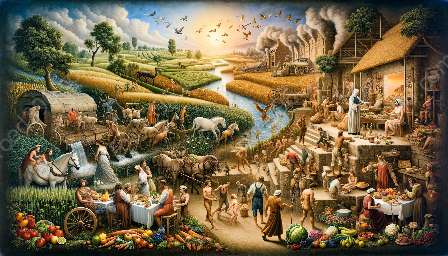The domestication of plants and animals has played a pivotal role in shaping human civilization, revolutionizing food production and agriculture, and influencing food culture and history. Join us on a journey through the historical developments that led to this transformation, and discover the significance of this process in shaping our world.
Understanding Domestication
The domestication of plants and animals refers to the process through which humans have selectively bred and tamed wild species for their benefit. This transformation from wild to domesticated species has been a millennia-long journey that has had a profound impact on human society.
Historical Developments in Food Production and Agriculture
The domestication of plants and animals marks a significant turning point in human history, leading to the establishment of sedentary agricultural societies. This shift from hunting and gathering to farming and animal husbandry laid the foundation for settled communities, surplus food production, and the rise of complex civilizations.
Historical evidence suggests that the earliest domestication efforts took place in the Fertile Crescent, an ancient region in the Middle East, where early farmers cultivated crops such as wheat, barley, and legumes, and raised livestock including goats, sheep, and cattle. The adoption of agriculture and animal domestication gradually spread across different regions, influencing cultural practices, trade, and the development of urban centers.
The Impact on Food Culture and History
The domestication of plants and animals not only transformed the way humans obtained their food but also deeply influenced food culture and history. The availability of domesticated crops and livestock led to the development of diverse cuisines, culinary techniques, and food traditions across different cultures.
Furthermore, the surplus food generated through agricultural practices enabled the specialization of labor, leading to the emergence of food artisans, chefs, and culinary experts. This specialization laid the groundwork for the rich tapestry of food culture that we witness today, with each region offering its unique flavors, ingredients, and culinary practices rooted in the domestication of plants and animals.
Impact on Modern Agriculture
The domestication of plants and animals continues to shape modern agriculture, with ongoing efforts to breed and cultivate new crop varieties with desirable traits such as disease resistance, high yield, and nutritional value. Similarly, animal husbandry practices have evolved to meet the demands of a growing population and changing dietary preferences.
Advancements in biotechnology and genetic engineering have further accelerated the domestication process, allowing scientists to modify plants and animals to enhance their productivity and adaptability to changing environmental conditions. These developments have significantly contributed to the sustainability and efficiency of food production, addressing the challenges of feeding an ever-growing global population.
Conclusion
The domestication of plants and animals stands as a testament to human innovation and ingenuity, shaping the course of history and leaving a profound impact on food production, agriculture, and food culture. As we continue to explore and expand our knowledge of domestication, it is essential to recognize and appreciate its historical significance and its ongoing influence on our modern world.

